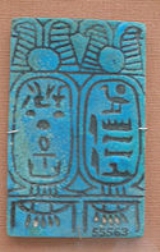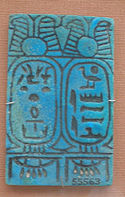
Anlamani
Encyclopedia
Anlamani was a king of Nubia
or Kush
who ruled from 620 BC and died around 600 BC.
 Anlamani used titles based on those of the Egyptian Pharaohs.
Anlamani used titles based on those of the Egyptian Pharaohs.
Horus name: Kanakht Khaemmaat ("Strong Bull appears in Equity")
Nebty Name: Seankhibutawy ("Nourisher of the Two Lands")
Golden Horus Name: Her(y)hormaat ("Who is satisfied with equity")
Prenomen: Ankhkare ("Re is one whose ka lives")
Nomen: Anlamani
Under his reign, Kush experienced a revival in its power. Anlamani was the son of Senkamanisken
, his predecessor, and the elder brother of Aspelta
, his successor.
. The stela records his mother Nasalsa's visit to Kawa to watch his official coronation as king. It also notes his decision to make four of his sisters as "sistrum
-players" in the National temple of Amun
at Gebel Barkal. and reports the king's campaign against certain nomadic tribes who threatened Kawa.
Two granite statues of this king have been found in Gebel Barkal while a block from Meroë
bearing his name is known. One of the statues is today located in the National Museum of Khartoum
, Sudan) while the other (a 12 foot high statue) is in the Boston Museum of Fine Arts. Anlamani was buried in pyramid Nu. 6 in Nuri
. In his tomb stood a large chamber, decorated with religious texts, and his sarcophagus
.
Sometime, in the reign of his brother Aspelta, the Egyptian king Psamtik II launched a campaign against Kush which resulted in the sack
of his kingdom's capital in 592 BC.
Nubia
Nubia is a region along the Nile river, which is located in northern Sudan and southern Egypt.There were a number of small Nubian kingdoms throughout the Middle Ages, the last of which collapsed in 1504, when Nubia became divided between Egypt and the Sennar sultanate resulting in the Arabization...
or Kush
Kingdom of Kush
The native name of the Kingdom was likely kaš, recorded in Egyptian as .The name Kash is probably connected to Cush in the Hebrew Bible , son of Ham ....
who ruled from 620 BC and died around 600 BC.

Horus name: Kanakht Khaemmaat ("Strong Bull appears in Equity")
Nebty Name: Seankhibutawy ("Nourisher of the Two Lands")
Golden Horus Name: Her(y)hormaat ("Who is satisfied with equity")
Prenomen: Ankhkare ("Re is one whose ka lives")
Nomen: Anlamani
Under his reign, Kush experienced a revival in its power. Anlamani was the son of Senkamanisken
Senkamanisken
Senkamanisken was a Nubian king who ruled from 640 to 620 BC at Napata.Senkamisken used titles based on those of the Egyptian Pharaohs.Horus name: Sehtawy...
, his predecessor, and the elder brother of Aspelta
Aspelta
Aspelta was a ruler of the kingdom of Kush .Aspelta used titles based on those of the Egyptian Pharaohs.Horus name: Neferkha Nebty Name: Neferkha...
, his successor.
Reign
Anlamani is particularly well known from a stela discovered in a temple at KawaKawa, Egypt
Kawa is a town in Sudan. Located in ancient Nubia between the Third and Fourth Cataracts of the Nile. Noteworthy archaeological discoveries include several Twenty-fifth dynasty of Egypt era steles .-References:...
. The stela records his mother Nasalsa's visit to Kawa to watch his official coronation as king. It also notes his decision to make four of his sisters as "sistrum
Sistrum
A sistrum is a musical instrument of the percussion family, chiefly associated with ancient Iraq and Egypt. It consists of a handle and a U-shaped metal frame, made of brass or bronze and between 76 and 30 cm in width...
-players" in the National temple of Amun
Amun
Amun, reconstructed Egyptian Yamānu , was a god in Egyptian mythology who in the form of Amun-Ra became the focus of the most complex system of theology in Ancient Egypt...
at Gebel Barkal. and reports the king's campaign against certain nomadic tribes who threatened Kawa.
Two granite statues of this king have been found in Gebel Barkal while a block from Meroë
Meroë
Meroë Meroitic: Medewi or Bedewi; Arabic: and Meruwi) is an ancient city on the east bank of the Nile about 6 km north-east of the Kabushiya station near Shendi, Sudan, approximately 200 km north-east of Khartoum. Near the site are a group of villages called Bagrawiyah...
bearing his name is known. One of the statues is today located in the National Museum of Khartoum
Khartoum
Khartoum is the capital and largest city of Sudan and of Khartoum State. It is located at the confluence of the White Nile flowing north from Lake Victoria, and the Blue Nile flowing west from Ethiopia. The location where the two Niles meet is known as "al-Mogran"...
, Sudan) while the other (a 12 foot high statue) is in the Boston Museum of Fine Arts. Anlamani was buried in pyramid Nu. 6 in Nuri
Nuri
Nuri is a place in modern Sudan on the south side of the Nile. Close to it, there are pyramids belonging to Nubian kings. Nuri is situated about 15 km north of Sanam, and 10 km from Jebel Barkal. All these remains belonged to the ancient city Napata, the first capital of the Nubian kingdom of...
. In his tomb stood a large chamber, decorated with religious texts, and his sarcophagus
Sarcophagus
A sarcophagus is a funeral receptacle for a corpse, most commonly carved or cut from stone. The word "sarcophagus" comes from the Greek σαρξ sarx meaning "flesh", and φαγειν phagein meaning "to eat", hence sarkophagus means "flesh-eating"; from the phrase lithos sarkophagos...
.
Sometime, in the reign of his brother Aspelta, the Egyptian king Psamtik II launched a campaign against Kush which resulted in the sack
Looting
Looting —also referred to as sacking, plundering, despoiling, despoliation, and pillaging—is the indiscriminate taking of goods by force as part of a military or political victory, or during a catastrophe, such as during war, natural disaster, or rioting...
of his kingdom's capital in 592 BC.
External links
Preceded by: Senkamanisken Senkamanisken Senkamanisken was a Nubian king who ruled from 640 to 620 BC at Napata.Senkamisken used titles based on those of the Egyptian Pharaohs.Horus name: Sehtawy... |
Rulers of Kush | Succeeded by: Aspelta Aspelta Aspelta was a ruler of the kingdom of Kush .Aspelta used titles based on those of the Egyptian Pharaohs.Horus name: Neferkha Nebty Name: Neferkha... |

